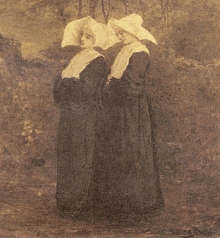Cornette


A cornette is a piece of female headwear that was especially popular in Europe in the 15th to 17th century. It is essentially a type of wimple consisting of a large starched piece of white cloth that is folded upwards in such a way as to create the resemblance of horns (French: cornes) on the wearer's head.
It was reported in The Times to have been "in fashion among the Ladies of Paris" in 1801,[1] made of muslin or gauze and richly ornamented with lace.
Use by the Daughters of Charity
The cornette was retained as a distinctive piece of clothing into modern times by the Daughters of Charity, a Roman Catholic society of apostolic life founded by St. Vincent de Paul in the mid-17th century.[2] The founder wanted to have the sisters of this new type of religious congregation of women, that tended to the sick poor and were not required to remain in their cloister, resemble ordinary middle-class women as much as possible in their clothing, including the wearing of the cornette.
After the cornette generally fell into disuse, it became a distinctive feature of the Daughters of Charity, making theirs one of the most widely recognised religious habits. Because of the cornette, they were known in Ireland as the "butterfly nuns". They abandoned the cornette on 20 September 1964.
In popular culture
- The headgear of the nuns in the American 1960s TV series The Flying Nun was meant to be a reference to (and spoof of) the cornette. The premise of the entire series is that the titular flying nun (played by Sally Field) is so slight that when her cornette is struck by a strong wind, it lifts her off her feet and enables her to "fly".
- In Margaret Atwood's The Handmaid's Tale, the handmaids' nun-like red habits include starched white cornettes described as wings, which prevent them both from revealing their faces and from seeing their surroundings.
- In the opening sequence of Jacques Tati's 1967 film Playtime, the cornettes of two nuns move like wings as they walk in an airport.
- In the movie Pee-wee's Big Adventure the cornette is depicted as being worn by the nuns including Pee Wee in the scene within a scene when Pee Wee recovers his bicycle.
- World Wrestling Federation tag team The Flying Nuns wore cornettes to the ring and wrestled in nun outfits.
- In the 2006 Doctor Who episode, New Earth, the humanoid cat people of the Sisters of Plenitude wear a cornette with their gowns.
- The cornettes worn by the St. Vincent nuns were a popular inspiration for painter Robert Vickrey.
See also
References
- ↑ "Parisian Fashions". News. The Times (5002). London. 13 January 1801. p. 3.
- ↑ "Daughters of Charity: Province of the West » History". daughtersofcharity.com. Retrieved 2016-11-13.
External links
| Wikimedia Commons has media related to cornettes. |
